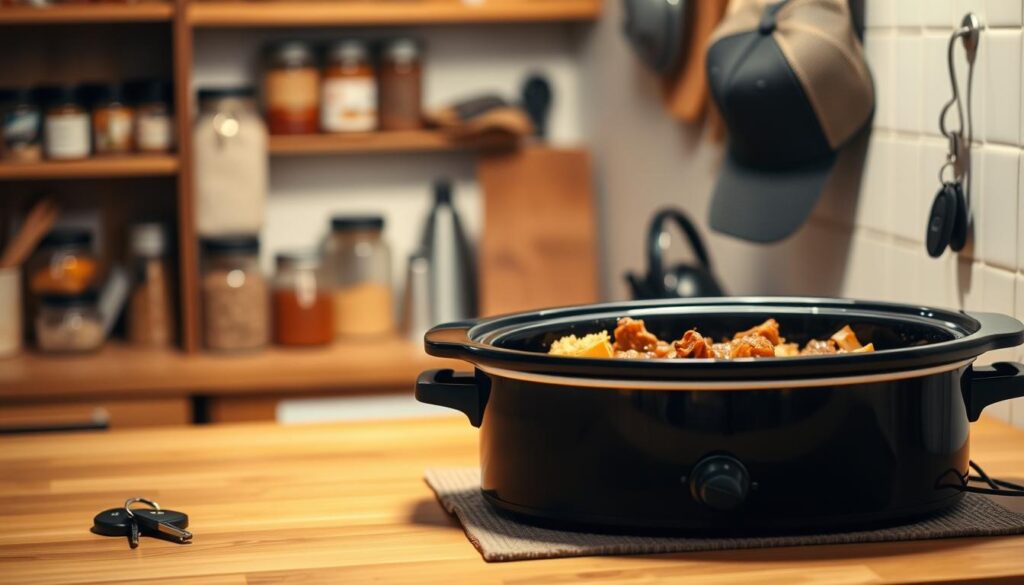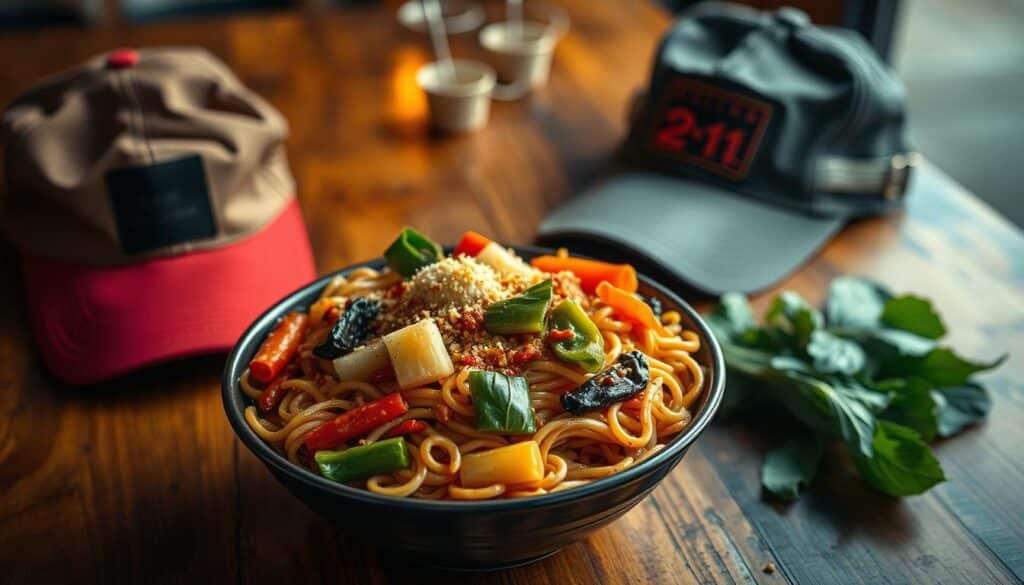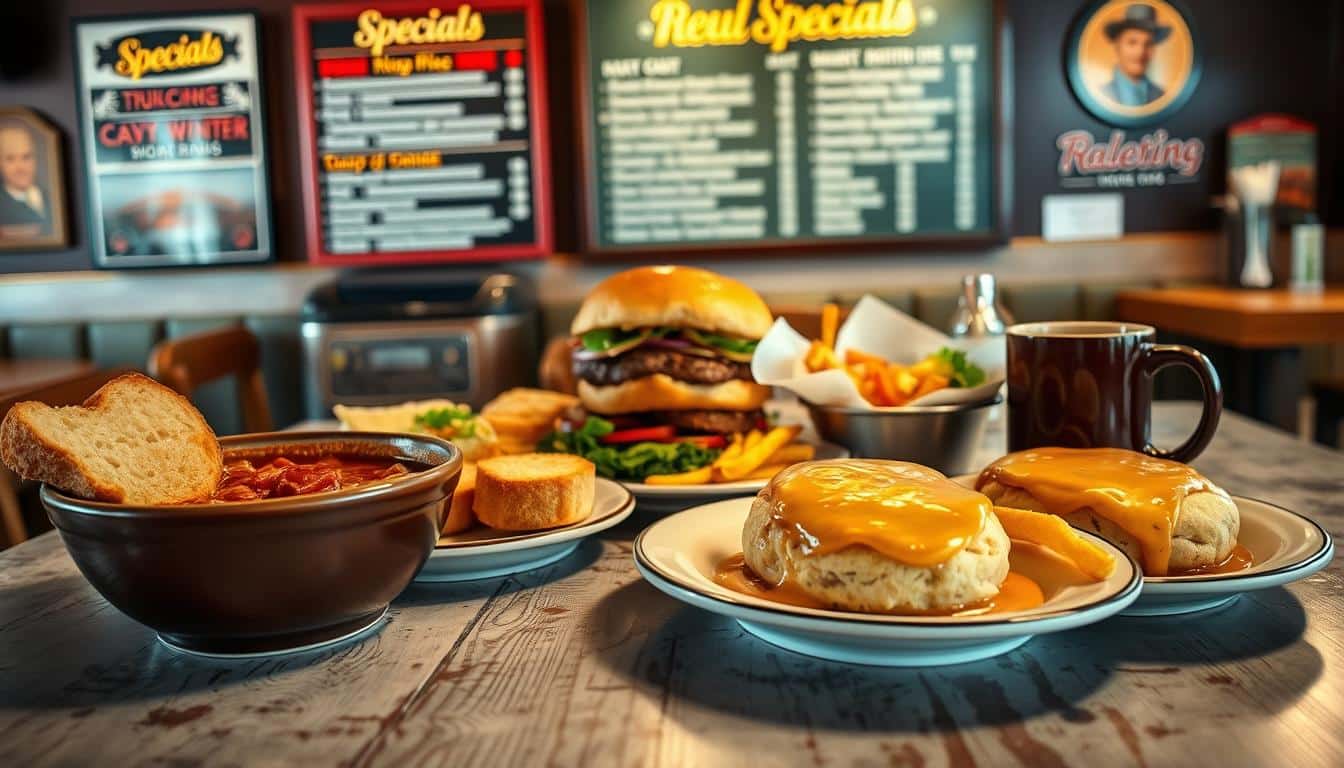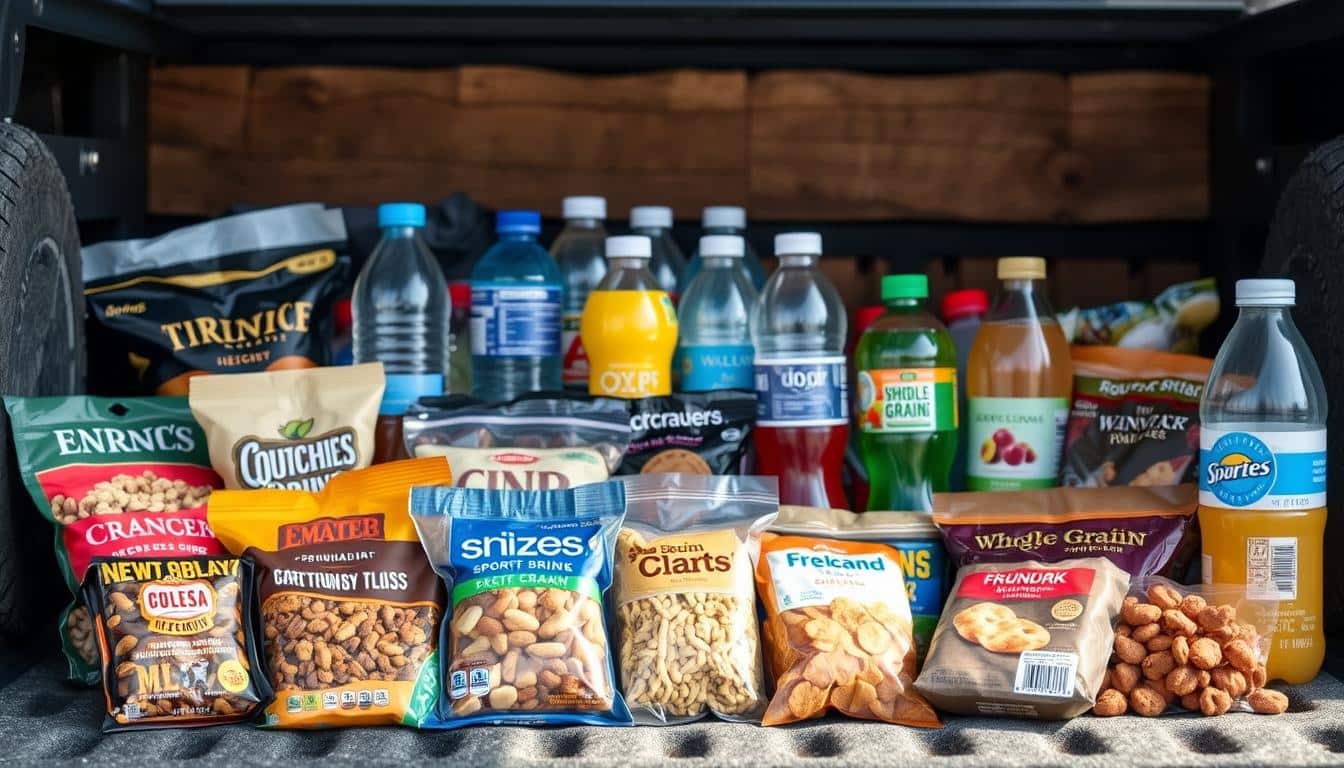Driving on the road often leads to long periods without stores. This forces drivers to eat at diners or truck stops. Such places offer quick food, but it’s usually not the healthiest. Truckers looking for healthier options can try cab cooking for better meals.
By using compact tools like 12-volt coolers and lunchbox cookers, drivers can make tasty and healthy meals. These gadgets let you whip up dishes like one-pot pasta and slow cooker dinners. You don’t even need a full kitchen.
Planning your meals is important. Investing in a small slow cooker, a power inverter, and a mini-fridge helps a lot. It’s crucial to reheat food to 165°F and store it properly to avoid waste.
This guide shares tasty and simple recipes perfect for truckers. It covers everything from great-tasting meals to quick snacks for the road. Follow these tips to enjoy better meals while on your journey.
Why Truck-Friendly Cooking Matters for Health and Budget
Long road days limit food choices for drivers. They often eat at truck stops, choosing meals that are heavy in calories, fat, and salt. This eating habit can harm a driver’s health and reduce energy over time.
By cooking in their trucks, drivers can manage portion sizes and the amount of salt and fat in their meals. Planning meals ahead means they can enjoy vegetables, lean meats, and whole grains. Such foods keep drivers alert and energized for the journey ahead.
Cooking in the truck is also more budget-friendly than eating out. Using a slow cooker or rice cooker, drivers can make filling meals at a lower cost. Cooking in batches and using freezer bags helps save money and reduces waste.
There are more pluses to making meals in a truck than just saving money. Small cooking devices allow for healthier meals like quinoa salads and veggie soups. These tools also save time, reduce the temptation to eat poorly, and add variety to meals.
Cooking in a small space is uniquely suited to life in a cab. Compact cooking equipment needs little power and space. Keeping the pantry organized and following simple recipes can uphold health without needing a full kitchen.
- Nutrition challenges on the road: limited produce, frequent fried options, hidden sodium.
- Cost savings and meal control: batch cooking, slow-cooker meals, planned shopping lists.
- Small-space cooking advantages: efficient appliances, neat storage, faster cleanup.
Essential Cab Cooking Gear and Power Tips
Working in a small space? Choose gear that fits well and cooks safely. It’s also crucial to pick items that use power efficiently. The best gear for cab cooking can turn your truck into a cozy kitchen on wheels. Look for appliances that are easy to lock, seal, and clean. This helps minimize messes and saves you time.
Must-have portable appliances
Start with small tools that plug into your truck’s 12V sockets or can run on an inverter. A compact slow cooker and a 4-quart crockpot come in handy for simple, one-dish meals. Their locking lids prevent spills during travel. A travel rice cooker and a versatile mini cooker offer more food choices while cutting down on fast food.
Don’t forget about a reliable cab fridge or a top-notch 12V cooler. These are essential for storing fresh ingredients like veggies and meats. Mason jars that seal tight and a small food sealer make prepping meals ahead of time easy. They’re great for salads, overnight oats, and other quick-fix foods.
Electrical setup and safety
Power your 110V appliances with a truck inverter attached to the 12V system. For low-power devices like slow cookers, a 300–600 watt inverter works best. It prevents electrical overloads. Always match your inverter’s power to the appliance’s needs to dodge electrical issues.
Keep your starter battery safe by installing an extra battery or setting up two batteries. A smart battery isolator or an auto charger prevents your fridge and cooker from draining the battery. Carry inline fuses and a simple multimeter to check for electrical problems.
Storage and sanitation in the cab
Keeping your food safe starts with smart storage. Keep raw meat separate from foods you can eat without cooking. Always use different cutting boards and knives for meat and veggies to stop germs from spreading.
Cool down leftovers fast and refrigerate them within two hours. Heat them to at least 165°F before eating. It’s also smart to have cleaning wipes, dish soap, and a durable cutting board ready for quick clean-ups.
- Pack washable rags, resealable bags, and labeled containers to keep things tidy.
- Choose stackable utensils and appliances to save space and prevent them from moving during drives.
- Look for appliances with secure lids and handles that don’t get hot for safety on bumpy roads.
Meal-Prep Strategies for Busy Drivers
Begin with a single meal or a week’s worth to find what works best. Achieving small wins early makes meal prep manageable for truckers. Choose a favorite protein and find three ways to enjoy it. This keeps your diet varied without needing extra trips to the store.
Batch cooking can save you time when you’re on long trips. Cook lots of rice, one-pot pasta, or stew and separate them into meals. These staples reheat well. They can be combined with fresh veggies or sauces to keep flavors exciting.
- Use a rice cooker or Instant Pot for grains that stay fresh longer.
- Prepare slow-cooker stews and freeze what you don’t eat right away.
- Make mason-jar salads for quick lunches.
Meals in freezer bags reduce prep time. Write the dish’s name and how to cook it on each bag. Fill bags with ingredients for chili, chicken, or vegetable stews, then freeze. Just thaw them in the fridge the night before and they’re ready to cook on a break.
Portioning snacks helps avoid overeating and keeps your energy up. Put nuts, dried fruits, carrots, and apples in small bags. Opt for fresh fruits and veggies instead of chips. This way, you control calories without losing variety.
- Put together 1-cup snack mixes for easy grabbing.
- Put hummus or yogurt in single-serve containers.
- Keep protein snacks close to the driver’s seat for quick access.
Opt for recipes that are simple with few ingredients. This saves on both prep and cleanup time. Use canned beans, frozen veggies, and pre-cut meats to minimize waste and speed up meal assembly. Spend a rest stop preparing a couple of meals to make the week go smoothly.
Plan some quick meals and a few that take more time to cook. Carry soups and stews in thermoses if you can’t reheat them. This approach keeps eating interesting. It also maximizes the benefits of batch cooking, freezer bag meals, and smart snack choices.
Breakfast Ideas That Fuel Long Hauls
A good morning starts your day right, especially for truckers. These breakfast tips are for meals that are easy to take with you, quick to make, and provide lasting energy. They help drivers stay sharp and skip time-consuming stops at diners.
Overnight oats and thermos breakfasts
Truckers enjoy overnight oats because they’re simple. Just mix rolled oats with milk or yogurt, add some fruit and nuts, and then put it in a jar. Let it chill all night, and it’s ready to eat in the morning without heating. If you prefer something warm, try a thermos for breakfast. Pour hot oatmeal flavored with apple and cinnamon or a tasty soup into a steel thermos. It keeps your meal hot for hours and reduces the need to stop.
Make-ahead egg options
Make-ahead eggs are a time-saver and pack in protein. Bake an egg casserole with veggies and some pulled pork, then cool, slice, and store it. You can heat it up in a microwave at truck stops or eat it cold if you’re in a hurry. Eggs boiled hard and egg muffins kept cool are easy to grab and go for those rushed mornings.
Quick grab-and-go options
Always have muffins filled with oats and nuts, energy bars, and fruit ready to grab. Foil-wrapped breakfast burritos heat up well at truck stops. Oatmeal made in a rice cooker or slow-cooked apples and cinnamon can be portioned into jars for quick grabs. Combine these with a hot thermos breakfast for more variety when needed.
Combining make-ahead eggs with jars of overnight oats offers different meals throughout the week. Change up with muffins, boiled eggs, and thermos meals to keep things interesting, balanced, and quick.
Lunches You Can Assemble in Minutes
Lunches on the go should be quick, tasty, and satisfying. Truckers can count on simple staples for easy midday meals. A small cooler or insulated bag will keep food cold until it’s time to eat.
Mason jar salads stay crisp and are easy to make. Start with dressing at the bottom, add hardy veggies, then proteins, and greens last. Shake it up when you’re ready to eat. These salads are perfect for truckers and save space too.
Salads in a jar and protein bowls
Mason jar salads and protein bowls make a great combo. Prepare quinoa or rice and store in portions. Throw in some chicken, tofu, or beans, and add veggies. Use a light dressing of lemon or yogurt before eating.
Wraps, sandwiches, and lettuce wraps
Wraps and sandwiches are great for meals without heat. Try mozzarella, tomato, and avocado on whole grain bread or a turkey and spinach wrap. Use lettuce wraps for fewer carbs and less mess when it’s hard to keep things cool.
Cold protein packs and tuna/chicken salads
Making cold protein packs is easy. Include grilled chicken, hard-boiled eggs, cheese, and sliced veggies with crackers. Mix tuna or chicken with mayo and celery for quick salads.
- Pack ready-to-eat vegetables for quick snacks.
- Single-serve hummus or dressing cups help manage portions.
- Have crackers or whole-grain bread ready for pairing with salads and spreads.
Plan some simple meal options and change them up weekly. This keeps lunch exciting and helps truckers eat healthy on long trips.
Dinner Recipes for Slow Cookers and One-Pot Meals
After long days, we need meals that cook themselves yet feel like home. Choose the right tools: a snug 4-quart slow cooker with a locking lid, a compact rice cooker, and a light skillet. These items make preparing slow cooker meals, one-pot pasta, rice cooker dinners, and skillet dishes simple and mess-free in your cab.

Slow cooker favorites for the cab
A programmable slow cooker is perfect for easy dinners. Try tasty pork chops with apples and onions. Or go for beef stew with tiny potatoes, or simple 3-ingredient chicken with salsa and beans. Make large batches of chili or pot roast, then store in portions. This works well for meals on several nights.
Go for lean meat cuts and toss in frozen veggies at the end. The locking lid keeps your meals inside, not all over, when moving. These slow cooker recipes are not only time savers but also make eating on the road affordable.
One-pot pasta and rice cooker meals
With one-pot pasta, mix dry pasta, canned tomatoes, sliced veggies, and broth all at once. Stir, then let it sit while you take a break. One-pot meals are a hit for their easy prep and cleanup. Plus, they rely on ingredients that last.
Rice cookers are great for more than just rice. Try them for quinoa, steamed veggies, or easy curries with store-bought sauce and chicken. Rice cooker meals need little work and always come out right.
Skillet stir-fries and quesadillas
A small nonstick skillet is perfect for quick meals. Whip up stir-fries with pre-chopped veggies and cooked meat in less than ten minutes. Keep soy sauce and garlic ready for flavor. Quesadillas with tortillas, cheese, and diced chicken are quick, hearty, and easy to customize.
Finish skillet meals with some lime or fresh spinach. These meals are perfect after driving all day. They’re warm, filling, and easy to clean up after.
Snacks and Desserts That Don’t Break the Diet
On long routes, it’s key to choose snacks that keep you going without messing with your sleep or waistline. Smart picks help you stay full on the road. Try to pack a variety of fresh fruits, proteins, and some simple treats for ease and enjoyment.
Healthy snack options
Trail mix with almonds, walnuts, and dried fruit can keep energy up for hours. Hummus with veggies like carrots or cucumbers is a great crunchy option. Adding cheese, crackers, and lean meats can make a satisfying mini meal.
Salads with quinoa, beans, or veggies are good for nutrients and easy to carry. Popcorn is a great snack for a light crunch. Pick snacks with less sugar and more protein for better energy.
Portable desserts and treats
Frozen grapes are sweet, cold, and easy to keep in a cooler. Fruit bars and ice pops are perfect for hot days. For a treat, a small scoop of ice cream from a truck stop is okay sometimes.
If you have access to a grill, try honey-lime drizzled fruit skewers. Slow-cooker apple-cinnamon oatmeal is great for dessert or breakfast. Add a bit of vanilla ice cream for a special touch.
Smart swaps to reduce sugar and sodium
Make smart choices to cut down on empty calories. Opt for dried fruit over candy, Greek yogurt over sugary parfaits, and choose air-popped popcorn instead of chips. Use low-sodium soy sauce in noodles to reduce salt but keep flavor.
- Replace sugary granola bars with nut-and-seed bites.
- Choose fresh fruit over syrupy canned options.
- Read labels and pick low-sodium snacks when possible.
These easy swaps help keep snacks tasty and healthy. Even on the road, you can enjoy great snacks and desserts. Just choose wisely at grocery stops and plan your snacks before each trip.
Three Go-To Recipes for Every Trucker
On the road, you need meals that are easy, tasty, and keep well. These three recipes are perfect for cab kitchens, motel stays, or tailgating. They all use simple pantry items, ready-to-eat proteins, and vegetables that cook quickly. This helps save time and money.

Ramen noodle stir-fry upgrade
- Forget the seasoning packet. Just cook the ramen, drain it, and put it aside.
- Sauté a bag of frozen veggies with low-sodium soy sauce and sesame oil.
- Mix in pre-cooked chicken, shrimp, or tofu. Combine with the noodles and veggies.
- Top it off with green onions and some Sriracha or chili flakes for spice.
- Tip: carry extra sauce in a leak-proof container to make reheating easy.
Loaded baked potato foil packets
- Slice russet potatoes thin or pre-cook them until they’re a bit soft.
- Stack the potato slices in heavy-duty foil with cheddar, bacon or ham, and green onions.
- Add salt, pepper, and a bit of garlic powder. Seal the packets well.
- Cook on a grill or burner for 15–20 minutes until the potatoes are soft.
- Enjoy with sour cream and chives.
Veggie stir-fry and protein bowls
- Cook grains like quinoa or brown rice in a rice cooker or slow cooker.
- Mix in pre-cut veggies, canned beans, or edamame with cooked protein like pork, chicken, or tofu.
- Add some low-sodium sauce and divide into containers for ready meals.
- Slow-cooked pork or pot roast are great for quick, reheatable protein bowls.
- These bowls are a hit with truckers since they reduce stops and maintain energy on long drives.
These recipes are key for easy trucking meals that make the most of ingredients and time. Switch up the proteins and sauces for variety. Use leftovers in omelets, quesadillas, or egg dishes for breakfast the next day.
Food Safety and Storage Best Practices on the Road
Keeping food safe in a truck cab takes planning and simple habits. Proper storage, smart reheating, and clean handling cut the risk of illness. Use compact gear and routines that fit a driver’s schedule to protect meals and maintain energy on long routes.
Safe temperature and reheating guidelines
Reheat leftovers until they’re 165°F to kill harmful bacteria. Use a digital food thermometer for soups, stews, and casseroles. When you don’t have a microwave or stove, use an electric lunchbox or portable cooker.
Cool cooked food quickly by dividing large batches into shallow containers before chilling. Store refrigerated meals at or below 40°F. Without a fridge, use a cooler with ice packs and change packs daily.
Avoiding cross-contamination and spoilage
Keep raw meat away from ready-to-eat foods to avoid cross-contamination. Use separate cutting boards and utensils for raw proteins and vegetables. Wash hands and tools after handling raw items and before touching other foods.
- Package raw meat in leak-proof containers inside coolers.
- Use single-serve condiment packets like sour cream and mustard for hygiene.
- Label leftovers with dates and toss slow-cooker meals after 3–4 days refrigerated.
Using thermoses and insulated containers
Thermos meals truckers rely on are ideal when reheating is impossible. Fill thermoses with hot foods straight from the stove to keep them warm. For cold items, insulated lunch boxes keep salads, sandwiches, and wraps fresh.
Choose thermoses with wide mouths for easy use. Secure lids and locking slow cookers prevent spills. Rotate ice packs in coolers and check seals to keep a stable temperature.
Simple routines beat complex systems. Pack with separation in mind, check temperatures, and use insulated gear to protect food. These small steps improve truck food safety and make meals on the road more reliable and enjoyable.
delicious and easy trucker meals
Eating well on the road is simple. You don’t need to be a chef. With smart swaps and tools, drivers can enjoy tasty meals right in their cab. Start with easy meal prep. Combine different proteins, grains, and sauces. This helps create a healthy routine, even with a busy schedule.
Balancing taste, convenience, and nutrition
- A compact rice cooker or a slow cooker makes cooking whole meals easy.
- Keep pre-cut veggies, canned beans, and cooked chicken ready for quick meals.
- Pick low-sodium sauces and use herbs or citrus for added flavor without the salt.
Rotating menus to avoid boredom
- Plan meals such as one-pot pasta, stew, and wraps to change things up each week.
- Cook in batches for 3–4 days to keep meals varied and reduce waste.
- Change your proteins with different sauces and grains to keep meals interesting.
Real-world tips from drivers
- Get a good inverter and battery for reliable power to your appliances.
- Opt for slow cookers with locking lids and timers for spill-free, timely meals.
- Freeze meals in labeled bags and reheat to 165°F for safe eating; keep raw food separate.
These tips from drivers show how to enjoy good trucker meals without losing flavor or health. Just a rotation plan and some useful tools can turn simple ingredients into great meals. These keep drivers going strong during long hauls.
Conclusion
Truckers can make their cabs feel like home kitchens by using simple recipes and certain kitchen tools. Things like thermoses, a small rice cooker, or a slow cooker can make dishes like one-pot pasta and hearty stews simple to whip up. This approach saves money and cuts down on eating unhealthy meals from truck stops.
Prepping meals in batches and using freezer bags not only saves time but also helps manage portion sizes. To keep everything running smoothly, having a good electrical setup is crucial—this includes an inverter and a strong battery. It’s also important to follow food safety rules like cooling down food properly and reheating to 165°F to stay healthy on long trips.
The takeaway here is clear: eating well while on the road is totally possible. A little planning and the right equipment can go a long way. Starting small, picking the right tools, and making meal prep a regular part of life can all help truckers eat better on the go.
FAQ
Why should truck drivers cook in the cab instead of eating at truck-stop diners?
What portable appliances are most useful for truck-friendly cooking?
How do I power appliances safely in my truck?
What are quick, healthy breakfast ideas for drivers?
Which lunches are simplest to assemble on the road?
What dinner recipes work well with slow cookers and one-pot methods?
How can I prep meals efficiently with limited time and space?
What snacks and portable desserts are truck-friendly and healthier?
How do I keep food safe in the cab and avoid spoilage?
What are low-prep meal ideas that still taste good?
How can I vary meals so I don’t get bored on long trips?
Are there safety tips for using slow cookers and other appliances while driving?
What refrigeration options work best when a fridge isn’t available?
How many times can I repeat a keyword like “slow cooker” or “meal prep” in a FAQ without overusing it?
What are quick safety checks before reheating or eating road-cooked food?
Can I prepare balanced meals that are budget-friendly on the road?
Which small appliances require the least power and still expand meal options?
How long will cooked meals last in the cab if I refrigerate properly?
What simple tools improve hygiene and prep speed in a tight space?
How can I use leftovers creatively to make new meals?
Content created with the help of Artificial Intelligence.



